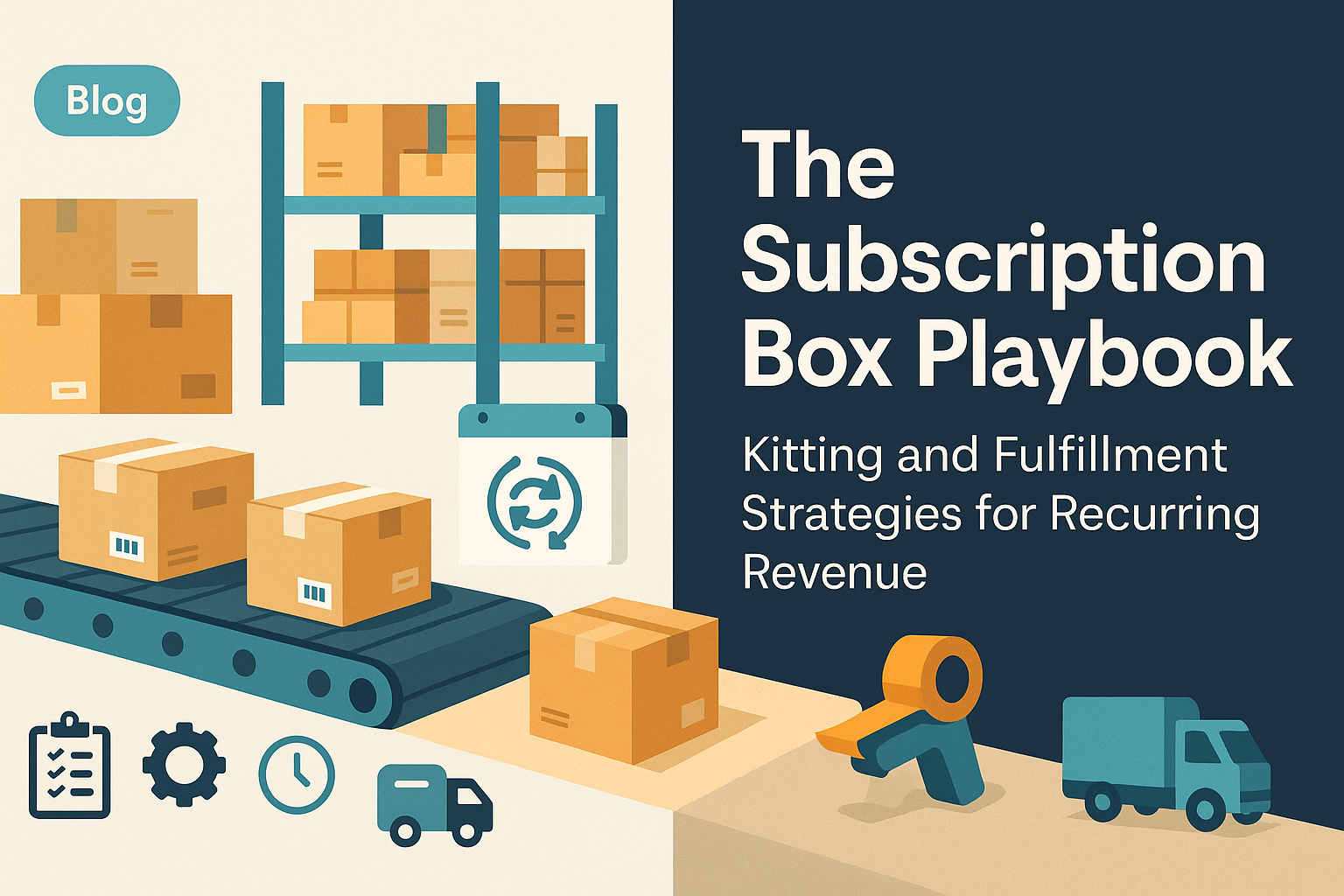This guide delves deep into the essential strategies you need to master. We’ll explore why kitting is more than just assembly, how strategic fulfillment can reduce your costs and delight your customers, and provide actionable insights to build a subscription box operation that is both profitable and primed for long-term success.
What is Kitting in a Subscription Box Context?
At its core, kitting is the process of grouping individual products into a single, ready-to-ship unit. For subscription boxes, this involves taking multiple items—a mix of cosmetics, gourmet snacks, or craft supplies—and combining them into a final package. This isn’t a random act; it’s a meticulously planned operation that significantly streamlines the fulfillment process. Instead of pickers having to find and select each individual item for every order, they simply pick one “kit” and pack it.
The Critical Role of Kitting in E-commerce and FBA
While the concept is simple, its impact is profound. For e-commerce businesses, especially those leveraging platforms like Amazon FBA (Fulfillment by Amazon), kitting is an essential strategy for efficiency and brand control. For example, if you sell a “monthly coffee sampler” that includes a bag of coffee, a branded mug, and a small booklet, kitting this as a single SKU (Stock Keeping Unit) offers several key advantages:
- Reduced Pick-and-Pack Time: A single scan of the kit’s barcode is all that’s needed, drastically cutting down on labor costs and processing time per order.
- Improved Accuracy: By preparing the kits in a controlled environment, you minimize the risk of human error, ensuring every customer receives the correct items.
- Enhanced Brand Presentation: Kitting allows you to create a beautiful, branded unboxing experience with custom inserts, tissue paper, and perfect product placement—an essential element for subscription box success.
The Fulfillment Challenge: Why Speed and Accuracy Matter
Once your kits are ready, the next step is getting them to your customers. Fulfillment is the process that handles everything from the moment an order is placed to the moment it arrives at the customer’s door. For subscription box businesses, this requires a specialized approach.
Key Fulfillment Strategies for Subscription Boxes
The rhythm of a subscription box business is unique. Most orders process on or around the same date each month, creating massive, predictable volume spikes. A fulfillment partner must be able to scale operations to handle these peaks with precision. Here are the most effective strategies:
Dedicated Batch Processing
Instead of fulfilling orders daily, subscription box fulfillment centers often dedicate a specific period each month to process all recurring orders simultaneously. This allows for:
- Operational Efficiency: Staff can focus on a single task, moving through a high volume of identical orders quickly and efficiently.
- Inventory Management: It simplifies forecasting and ensures all necessary components are on hand for the monthly run.
- Consistent Delivery Schedule: Customers know exactly when to expect their box, building trust and anticipation.
Strategic Warehouse Locations
The location of your fulfillment centers directly impacts shipping costs and delivery times. A distributed network of warehouses can be a game-changer. For instance, a brand using a single warehouse in Texas might face high shipping costs and long transit times for customers on the East or West Coasts. However, by leveraging a network like the one at WarehouseTX, with locations in California, New Jersey, and Florida, you can significantly reduce both.
This geographic advantage is crucial for customer satisfaction, as faster delivery speeds often lead to higher retention rates and positive reviews.
Comparative Analysis: In-House vs. 3PL Kitting & Fulfillment
One of the biggest decisions a subscription box entrepreneur faces is whether to handle logistics in-house or partner with a 3PL (Third-Party Logistics) provider. Let’s break down the pros and cons.
| Feature | In-House Logistics | 3PL Partnership |
|---|---|---|
| Startup Cost | High. Requires investment in warehouse space, labor, technology, and equipment. | Low. No capital expenditure on infrastructure. Costs are variable based on volume. |
| Operational Control | Complete control over every step of the process. | Less direct control, but with a good partner, you get expertise and best practices. |
| Scalability | Difficult. Requires more space, staff, and tech, which can be slow and expensive to acquire. | Highly scalable. A 3PL can easily ramp up operations for peak seasons or rapid growth. |
| Expertise & Efficiency | Requires internal training and a learning curve to optimize processes. | Access to industry experts, optimized workflows, and advanced technology (e.g., WMS). |
| Focus | Takes valuable time away from core business activities like marketing and product development. | Frees up your team to focus on brand building, content creation, and customer acquisition. |
For most growing subscription box businesses, a 3PL partnership offers a clear path to scalability and profitability. It allows you to leverage the expertise and infrastructure of a logistics specialist without the significant upfront investment and ongoing management overhead.
Case Study: The “Artisan Snacks” Subscription Box
To illustrate these concepts, let’s look at a hypothetical case. “Artisan Snacks” is a small but growing subscription box company that sources unique, healthy snacks from around the world. Initially, the founders assembled and shipped the boxes themselves from their garage.
The Initial Challenge
As their subscriber count grew from 50 to 500, they faced a crisis. The monthly “pack day” was an all-hands-on-deck, 16-hour marathon. Boxes were sometimes missing items, shipping costs were high, and the founders were spending more time on logistics than on finding new products or marketing their brand. Their biggest pain points were:
- High labor hours for manual kitting and packing.
- Inaccurate inventory counts and occasional missing items in boxes.
- Excessive shipping costs due to a single shipping origin.
The 3PL Solution
They partnered with a 3PL that specialized in kitting services. The 3PL took over the entire process. Each month, the 3PL’s warehouse received all the individual snacks, and their team handled the kitting, adding custom branded materials, and preparing the boxes for shipment. Since the 3PL had a fulfillment center in their target market (California), their shipping costs were slashed, and delivery times were reduced from 5-7 days to just 2-3 days.
The Results
- Time Savings: The founders regained hundreds of hours a month, which they reinvested into content marketing, product sourcing, and customer service.
- Cost Reduction: They reduced overall logistics costs by 15% through more efficient shipping rates and labor savings.
- Customer Satisfaction: With accurate, on-time deliveries, their customer retention rate increased by 8%, and positive reviews soared.
This case highlights how a strategic partnership can unlock growth by solving the logistical headaches that often bottleneck a subscription business.
Essential Strategies for Your Subscription Box Playbook
Whether you’re just starting or looking to scale, here are key strategies to keep in mind:
- Plan Your Kits in Advance: Don’t wait until the last minute. Finalize your product list and kit components at least a month in advance to allow for proper inventory sourcing and kitting prep.
- Leverage Kitting for Upsells: Consider offering add-on products that can be kitted with the main box. This is a powerful way to increase average order value.
- Optimize Your Packaging: Work with your fulfillment partner to design packaging that is both protective and cost-effective. Check out our Packaging & Packing services to see how custom solutions can make a difference.
- Monitor Your Metrics: Keep a close eye on your shipping costs, delivery times, and returns. These metrics are your compass for success.
Frequently Asked Questions About Subscription Box Logistics
What is the difference between kitting and assembly?
While often used interchangeably, kitting is the process of combining products into a single SKU for future use, while assembly often refers to a more complex manufacturing or construction process. For subscription boxes, the term “kitting” is more precise, as it involves pre-packaging a set of items for efficient order fulfillment rather than building a product from raw components.
How can a 3PL help with my subscription box’s return management?
A 3PL can handle the entire reverse logistics process. They receive returned items, inspect them for damage, and then either restock them, dispose of them, or prepare them for a future kit. This frees up your time and ensures returns are handled professionally and efficiently. To learn more about this process, you can explore our Return Management solutions.
Is it more expensive to use a 3PL for subscription box fulfillment?
Not necessarily. While 3PLs charge a fee for their services, this cost often replaces the significant upfront and ongoing expenses of in-house operations (e.g., warehouse rent, labor, utilities, and technology). By leveraging a 3PL’s network and expertise, businesses often find they save money on shipping, reduce labor costs, and free up capital to invest in growth.
Mastering the art of kitting and fulfillment is not a small task, but it is the foundation of a successful subscription box business. By treating your logistics as a core part of your brand strategy—and by considering the power of a professional 3PL partner—you can ensure your operation is not just a source of monthly revenue, but a well-oiled machine built for sustainable growth.
Ready to streamline your subscription box logistics? Discover how WarehouseTX can help with our comprehensive Fulfillment Services and Packaging Solutions.

